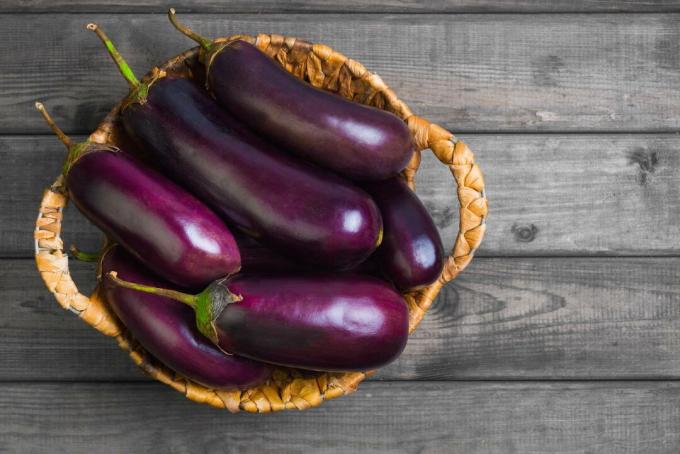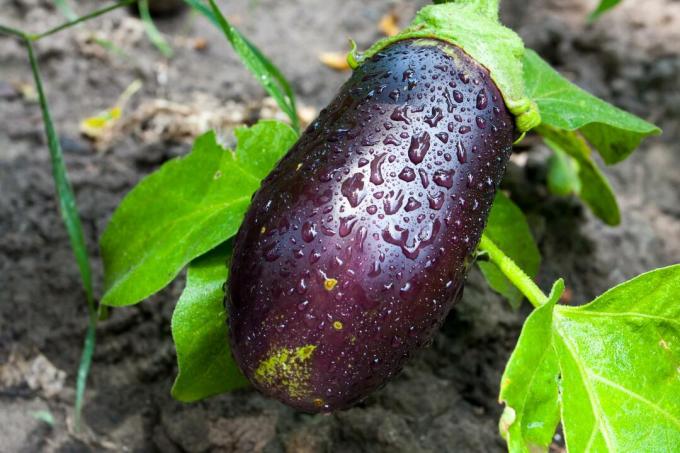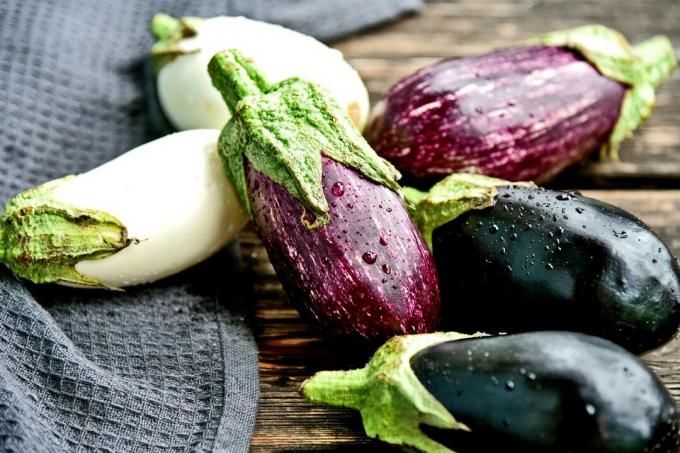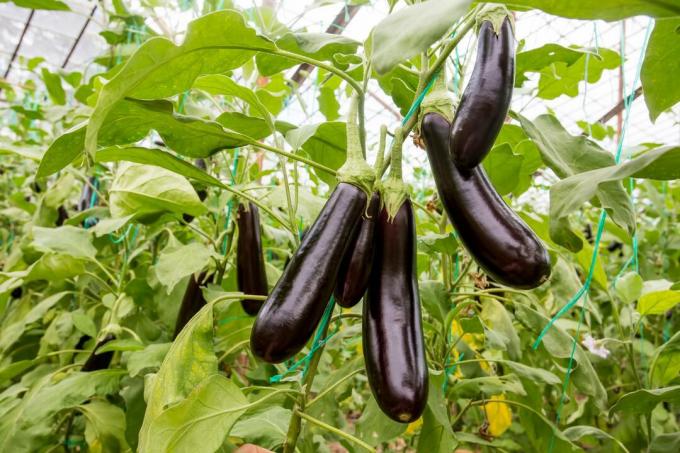The aubergine is a Mediterranean vegetable classic. Nevertheless, an eggplant plant can also be grown in this country with a few tips.
So far the eggplant (Solanum melongena) seldom found in the gardens of our latitudes and is mostly simply bought in the supermarket. But generally speaking, eggplant cultivation has a long cultural history. The eggplant is a nightshade family (Solanaceae) originally from East Asia. Over the centuries it has spread to the Mediterranean, where it can still be found on many plates today. In this country the aubergine plant is exposed to cooler temperatures - with the right technology, however, it can also be grown here. We give tips and tricks on how eggplant cultivation can also be crowned with success in your garden.
contents
- Eggplant: fruit or vegetables?
- Eggplant cultivation: when is the season?
-
Plant eggplants properly
- Planting eggplants in the open ground or in a greenhouse
- Eggplants in the pot
-
Caring for eggplants
- Skinned and cut eggplants
- Water and fertilize eggplants
- Eggplant Plants: Selected Varieties
- Harvest and store eggplants
Eggplant: fruit or vegetables?
Many wonder whether the eggplant is a fruit or a vegetable because of its unusual appearance. In fact, there are hardly any defined differences between fruit and vegetables, but eggplant is generally referred to as a fruit vegetable. Eggplant plants are usually cultivated perennial and are closely related to tomatoes and peppers, which are more likely to be referred to as vegetables. In addition, eggplant is not eaten raw and is not very sweet, so it is also classified as a vegetable.

Eggplant cultivation: when is the season?
Unlike many other vegetables, you should start sowing early. The season begins in winter from January-February with sowing in pots. The harvest can last from late summer to autumn. In general, the eggplant plant is a vegetable with a long growth period. The aubergine is a nightshade plant that (similar to the related tomato) is sensitive to cold. In our part of the world, we therefore recommend cultivation in a greenhouse. Alternatively, a sun-drenched place on the south side of buildings can be chosen. In any case, make sure that the location is sufficiently warm.

Plant eggplants properly
Since the aubergine is a very slow germinating plant (2-6 weeks), the seeds are sown from the end of January until the beginning of March at the latest and pulled forward on the windowsill. A temperature of 20-25 ° C is important. Sow the seeds 1 to 2 cm deep and then press the soil a little. As soon as the seeds germinate and the first leaves (not cotyledons) appear, eggplant plants can be pricked out. It is best to use pots that are not too small, as the young plants will still spend some time there.
Planting eggplants in the open ground or in a greenhouse
Just like all other heat-sensitive plants, the young eggplant plants can be planted outdoors after the ice saints from mid-May. Eggplants love nutrient-rich soil, so it is best to incorporate compost into them before planting them out. A greenhouse is perfect for growing aubergines, as the plants receive more heat there than would be the case outdoors. Plant the young eggplant plants at a distance of 60 x 60 cm. Since eggplants like to grow very expansive and the fruits can become heavy, a stick is recommended as a support for the plant. In the field, it is recommended to use a black mulch film at the beginning so that the plant has a warmer environment.

For the correct planting of eggplants, you should pay attention to these tips:
- Sow indoors from late January to early March (1-2 cm deep at at least 20 ° C)
- Prick out after the first leaves
- Plant out outdoors from the end of May in a protected location or in a greenhouse (distance 60 x 60 cm)
- Stick as a support for the plants
- Use black mulch film at the beginning as protection against the cold
Eggplants in the pot
Eggplant plants are also ideal for cultivation in pots, on the balcony or terrace. A sufficiently large bucket with a capacity of at least ten liters is important for successful rearing. Since it is a little cool for the exotic vegetables in many regions, a location directly on the house wall is recommended. The plant can thus benefit from the thermal radiation.
Caring for eggplants
In order for eggplant cultivation to be a success, you should follow several tips for caring for the plants:
Skinned and cut eggplants
In the case of eggplants, it can be worthwhile to remove some of the side shoots. This means that the plant has more energy to supply the remaining shoots and that it does not become too bulky. The procedure is as follows: Let only 2 to 3 main shoots grow and remove other side shoots regularly. Lower leaf shoots should also be removed. Unlike when skinning tomatoes, the shoots should be cut off with a sharp knife to avoid infections. As soon as flowers are formed, make sure that only 2 to 3 fruits are formed per shoot. This allows the plant to invest enough energy in the formation of the growing aubergines.

Water and fertilize eggplants
Eggplant plants should be watered regularly, otherwise the fruits can turn out smaller. It should be noted that watering more often when growing in a pot, as the soil dries out faster. Even so, you shouldn't over-water the plants either outdoors or in pots to minimize the risk of root rot. Eggplant plants, being heavy consumers in the garden, can tolerate a lot of nutrients. Even when planting, you should give mainly organic slow-release fertilizers such as our Plantura Organic tomato fertilizer be incorporated. Alternatively, compost is also suitable. This will give your eggplant plants an optimal start. After about three months there is another fertilization, ours here too Organic tomato fertilizer an excellent choice. There is an organic alternative Nettle manure at.
When caring for eggplant plants, the following tips should be followed:
- Take out the side shoots and only let 2-3 fruits grow per shoot
- Water plants regularly, but not excessively
- As fertilization at the beginning and a few months later Organic tomato fertilizer or Nettle manure use
Eggplant Plants: Selected Varieties
When you think of eggplant, you have the image of elongated and deep purple vegetables in your head. In fact, the variety variations are very unusual and range from the classic purple color to white varieties and striped specimens. We briefly present the most popular eggplant varieties before:
Classic appearance:
- Adria (F1): newer variety with club-shaped, dark purple fruits; good flavor.
- Anet (F1): classic eggplant look with club-shaped, dark purple to black fruits; particularly warmth-loving and ideally suited for cultivation in polytunnels or tomato houses.
- Money Maker (F1): modern variety, especially popular in hobby cultivation; precocious and productive; very elongated, dark purple fruits; requires less heat than other types.
- Ophelia (F1): Cultivation which, due to its compact growth, is particularly suitable for cultivation on the balcony or terrace; smaller, club-shaped and purple-colored fruits with a very good taste; very rich.

Exceptional varieties:
- Bambino: small, round fruits with purple color; is perfect for growing in a pot.
- Casper: club-shaped aubergine variety with a conspicuously white skin; particularly tender and fine pulp.
- Prosperosa: Traditional variety from Italy with spherical, deep purple (with a white border on the sepals) fruits; great taste.
- Violette di Firenze: white-light purple round fruits; traditional variety from northern Italy with medium heat requirements
Harvest and store eggplants
Depending on the variety and development, eggplants can be harvested from the end of July until the first night frosts in autumn. The correct harvest time is particularly important for eggplants, as they should not be eaten if they are harvested too early or if they are overripe. If the vegetables are still too unripe and green, consumption is poisonous and can lead to gastrointestinal complaints and vomiting. Responsible for this is the toxin solanine, which is formed by aubergines - as well as by the closely related tomatoes, potatoes and peppers. It is therefore particularly important to let eggplants ripen before harvesting until the green color has disappeared. If the fruit is overripe, it gradually turns brown and soft inside - also not really recommended for consumption.

Eggplants taste best when eaten right after harvest. Short storage is possible at low temperatures in the refrigerator. However, we always recommend consuming it within a few days.
More information about the Eggplant harvest and storage You will find here.



